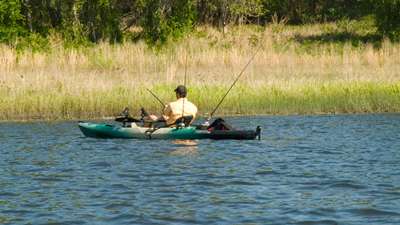
You know the bass are “right” when they attack chocolate cake. About once a week, I dispose of stale baked goods by feeding the panfish inhabiting the dense field of lily pads off my shoreline. When two errant throws left chunks of cake dimpling the pads, it must have looked like a frog or some other forage scampering overhead because as the next piece rolled off the edge, the water exploded with far more force than any bluegill I’ve ever met. Five minutes later, my Snag Proof frog crossed the same kill zone, and I caught the spunky 2-pound bass on the first shot.
Such is life on a small pond — often an unpredictable mix of quality and quantity, but frequently a respectable level of opportunity that does not require a fancy boat pushed by a lot of horses.
Unless you’re neighbors with a bass pro, small residential waters get little “serious” pressure, so the resident bass are mostly uneducated and fairly cooperative. That’s not to say strategy is unnecessary, so consider a few points:
Keep It Simple
One or two rods and a small tackle bag — or a gallon Ziploc bag — holds enough baits, hooks, weights and plugs for a successful outing. In many cases, one rod with a jig or Texas rigged plastic and another with a topwater bait will handle the job. (If you use a Ziploc, keep treble hooks under control by sticking pieces of plastic worm on the points until they’re needed.)
My go-to bait is weightless soft plastic stick bait like a Yum Dinger or a Wave Worms Tiki Stik. Rigged Texas style, I can hop this bait across pads, skip it under docks, twitch it through open spots on clear shorelines and jerk it along grass edges. Switching from Texas to wacky style expands the presentation. These dense body worms have a slow, meandering sink rate, but if I want to fall deeper, a nail or peg weight gets it to the bottom.
Small Approach
Johnboats with kickers usually suffice, but canoes and kayaks excel in the small pond. I’ve found that banking my flat bottom canoe in a grass edge or in thick pads holds the vessel still enough to stand up and cast. Just mind your balance on the hook set and sit down to fight the fish.
Seek Structure
Docks are the obvious targets, but also look for sunken boat hulls, discarded bricks or cinder blocks and even oddball objects like the vandalized newspaper rack I once found submerged in a residential pond.
Aquatic vegetation plays a big role here, as hydrilla mats and lily pad fields should have big, red, neon “Fish Here!” signs over them. Lacking consistent water movement, small ponds are easily overtaken by summer weed mats and thick, lumpy algae. Frogging and punching makes the most of these scenarios.
Current Events
From feeder creeks to storm drains, run-outs can be big-time bass magnets in a small pond, as any point of current represents a potential feeding site and warmth in cooler months.
A fellow homeowner has a storm water drain in the seawall next to his dock. During the summer rainy season, the current piles through a little gulley, past the dock and banks off the outer grass line. Fish feed all along the current edge, but the bigger ones usually sit with their noses right under the pipe, awaiting the next water-borne meal.
When I first approach the spot in my canoe, I can always count on sticking a couple of fish by casting a Texas rigged stick bait or frog right into the pipe. After the released fish rat me out to the others, I’ll move to the end of the dock, where the more wary fish wait and ambush.
Public Relations
Wave politely to homeowners who stroll out to check your progress. A courteous presence might reward you with a tip on where the big one likes to hide. On the flip side, educating other anglers — residents or visitors — on the importance of catch and release to a small pond will help ensure its continued productivity.





